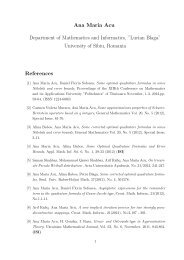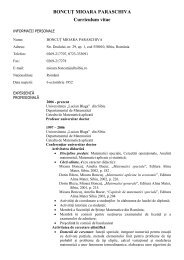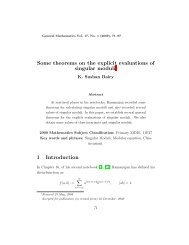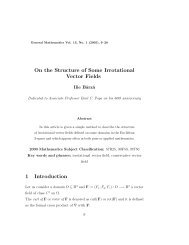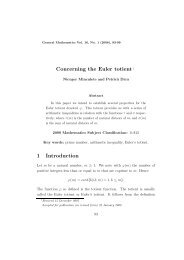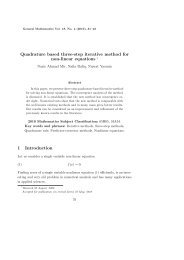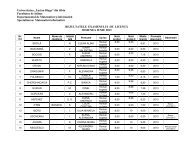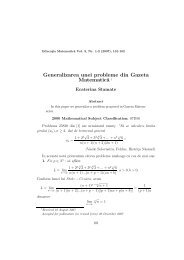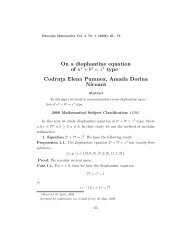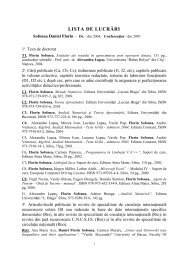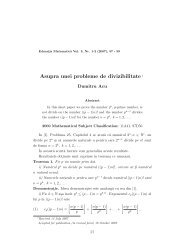Some multiplier difference sequence spaces defined by a sequence ...
Some multiplier difference sequence spaces defined by a sequence ...
Some multiplier difference sequence spaces defined by a sequence ...
Create successful ePaper yourself
Turn your PDF publications into a flip-book with our unique Google optimized e-Paper software.
General Mathematics Vol. 17, No. 3 (2009), 173–186<strong>Some</strong> <strong>multiplier</strong> <strong>difference</strong> <strong>sequence</strong> <strong>spaces</strong><strong>defined</strong> <strong>by</strong> a <strong>sequence</strong> of modulus functions 1Hemen DuttaAbstractIn this paper we introduce and investigate the <strong>multiplier</strong> <strong>difference</strong><strong>sequence</strong> <strong>spaces</strong> c 0 (F , ∆ n (m) , Λ, p), c(F , ∆n (m) , Λ, p) and l ∞(F ,∆ n (m) , Λ, p) <strong>defined</strong> <strong>by</strong> a <strong>sequence</strong> F = (f k) of modulus functions andp = (p k ) be any bounded <strong>sequence</strong> of positive real numbers. Westudy their different properties like completeness, solidity, monotonicity,symmetricity etc. We also obtain some relations betweenthese <strong>spaces</strong> as well as prove some inclusion results.2000 Mathematics Subject Classification: 40A05, 46A45, 46E30.Key words and phrases: Difference <strong>sequence</strong>, Modulus function,paranorm, completeness, solidity, symmetricity, convergence free,monotone space.1 Received 9 December, 2008Accepted for publication (in revised form) 17 March, 2009173
174 Hemen Dutta1 IntroductionThroughout the paper w, l ∞ , c and c 0 denote the <strong>spaces</strong> of all, bounded,convergent and null <strong>sequence</strong>s x = (x k ) with complex terms respectively.The zero <strong>sequence</strong> is denoted <strong>by</strong> θ = (0, 0, . . . ).The notion of <strong>difference</strong> <strong>sequence</strong> space was introduced <strong>by</strong> Kizmaz [4],who studied the <strong>difference</strong> <strong>sequence</strong> <strong>spaces</strong> l ∞ (∆), c(∆) and c 0 (∆). Thenotion was further generalized <strong>by</strong> Et and Colak [1] <strong>by</strong> introducing the <strong>spaces</strong>l ∞ (∆ n ), c(∆ n ) and c 0 (∆ n ). Another type of generalization of the <strong>difference</strong><strong>sequence</strong> <strong>spaces</strong> is due to Tripathy and Esi [10], who studied the <strong>spaces</strong>l ∞ (∆ m ), c(∆ m ) and c 0 (∆ m ). Tripathy, Esi and Tripathy [11] generalizedthe above notions and unified these as follows:haveLet m, n be non-negative integers, then for Z a given <strong>sequence</strong> space weZ(∆ n m) = {x = (x k ) ∈ w : (∆ n mx k ) ∈ Z},where ∆ n mx = (∆ n mx k ) = (∆ n−1m x k − ∆ n−1m x k+m ) and ∆ 0 mx k = x k for allk ∈ N, which is equivalent to the following binomial representation:∆ n mx k =n∑( ) n(−1) v x k+mv .vv=0Taking m = 1, we get the <strong>spaces</strong> l ∞ (∆ n ), c(∆ n ) and c 0 (∆ n ) studied <strong>by</strong> Etand Colak [1]. Taking n = 1, we get the <strong>spaces</strong> l ∞ (∆ m ), c(∆ m ) and c 0 (∆ m )studied <strong>by</strong> Tripathy and Esi [10]. Taking m = n = 1, we get the <strong>spaces</strong>l ∞ (∆), c(∆) and c 0 (∆) introduced and studied <strong>by</strong> Kizmaz [4].Let Λ = (λ k ) be a <strong>sequence</strong> of non-zero scalars. Then for E a <strong>sequence</strong>space, the <strong>multiplier</strong> <strong>sequence</strong> space E(Λ) associated with the <strong>multiplier</strong>
<strong>Some</strong> <strong>multiplier</strong> <strong>difference</strong> <strong>sequence</strong> <strong>spaces</strong> 175<strong>sequence</strong> Λ is <strong>defined</strong> asE(Λ) = {(x k ) ∈ w : (λ k x k ) ∈ E}The scope for the studies on <strong>sequence</strong> <strong>spaces</strong> was extended <strong>by</strong> using thenotion of associated <strong>multiplier</strong> <strong>sequence</strong>s. Goes and Goes [2] <strong>defined</strong> thedifferentiated <strong>sequence</strong> space dE and integrated <strong>sequence</strong> space ∫ E for agiven <strong>sequence</strong> space E, using the <strong>multiplier</strong> <strong>sequence</strong>s (k −1 ) and (k) respectively.A <strong>multiplier</strong> <strong>sequence</strong> can be used to accelerate the convergence ofthe <strong>sequence</strong>s in some <strong>spaces</strong>. In some sense, it can be viewed as a catalyst,which is used to accelerate the process of chemical reaction. <strong>Some</strong>times theassociated <strong>multiplier</strong> <strong>sequence</strong> delays the rate of convergence of a <strong>sequence</strong>.A function f : [0, ∞) −→ [0, ∞) is called a modulus if(a) f(x) = 0 if and only if x = 0,(b) f(x + y) ≤ f(x) + f(y), for x ≥ 0, y ≥ 0,(c) f is increasing,(d) f is continuous from the right at 0.Hence f is continuous everywhere in [0, ∞).The following inequality will be used throughout the article. Let p =(p k ) be a positive <strong>sequence</strong> of real numbers with 0 < p ≤ sup p k = G,D = max(1, 2 G−1 ). Then for all a k , b k ∈ C for all k ∈ N, we have|a k + b k | p k≤ D{|a k | p k+ |b k | p k}and for λ ∈ C,|λ| p k≤ max(1, |λ| G )
176 Hemen DuttaThe studies on paranormed <strong>sequence</strong> <strong>spaces</strong> were initiated <strong>by</strong> Nakano [8]and Simons [9] at the initial stage. Later on it was further studied <strong>by</strong> Maddox[7], Lascardies [5], Lascardies and Maddox [6], Ghosh and Srivastava[3] and many others.2 Definitions and PreliminariesA <strong>sequence</strong> space E is said to be solid (or normal) if (x k ) ∈ E implies(α k x k ) ∈ E for all <strong>sequence</strong>s of scalars (α k ) with |α k | ≤ 1 for all k ∈ N.A <strong>sequence</strong> space E is said to be monotone if it contains the canonicalpreimages of all its step <strong>spaces</strong>.A <strong>sequence</strong> space E is said to be symmetric if (x π(k) ) ∈ E, where π is apermutation on N.A <strong>sequence</strong> space E is said to be convergence free if (y k ) ∈ E whenever(x k ) ∈ E and y k = 0 whenever x k = 0.A <strong>sequence</strong> space E is said to be <strong>sequence</strong> algebra if (x k .y k ) ∈ E whenever(x k ) ∈ E and (y k ) ∈ E.Let p = (p k ) be any bounded <strong>sequence</strong> of positive real numbers andΛ = (λ k ) be a <strong>sequence</strong> of non-zero scalars. Let m, n be non-negativeintegers, then for a <strong>sequence</strong> F = (f k ) of modulus functions we define thefollowing <strong>sequence</strong> <strong>spaces</strong>:c 0 (F , ∆ n (m), Λ, p) = {x = (x k ) : limk→∞(f k (|∆ n (m)λ k x k |)) p k= 0},c(F , ∆ n (m) , Λ, p) = {x = (x k) : limk→∞(f k (|∆ n (m) λ kx k − L|)) p k = 0,
<strong>Some</strong> <strong>multiplier</strong> <strong>difference</strong> <strong>sequence</strong> <strong>spaces</strong> 177for some L ∈ C},l ∞ (F , ∆ n (m), Λ, p) = {x = (x k ) : sup(f k (|∆ n (m)λ k x k |)) p k< ∞},k≥1where (∆ n (m) λ kx k ) = (∆ n−1(m) λ kx k − ∆ n−1(m) λ k−mx k−m ) and ∆ 0 (m) λ kx k = λ k x kfor all k ∈ N, which is equivalent to the following binomial representation:n∑( ) n∆ n (m)λ k x k = (−1) v λ k−mv x k−mv .vv=0In the above expansion it is important to note that we take x k−mv = 0and λ k−mv = 0, for non-positive values of k − mv. Also it is obvious thatc 0 (F , ∆ n (m) , Λ, p) ⊂ c(F , ∆n (m) , Λ, p) ⊂ l ∞(F , ∆ n (m), Λ, p).The inclusions are strict follows from the following examples.Example 1 Let m = 2, n = 2, f k (x) = x 6 , for all k odd and f k (x) = x 2for all k even, for all x ∈ [0, ∞) and p k = 1 for all k ≥ 1. Consider the<strong>sequence</strong>s Λ = (k 8 ) and x = ( 1 ). Then x belongs to c(F, ∆ 2 k 6 (2), Λ, p), but xdoes not belong to c 0 (F, ∆ 2 (2), Λ, p).Example 2 Let m = 2, n = 2, f k (x) = x 2 , for all k ≥ 1 and x ∈ [0, ∞)and p k = 2 for all k odd and p k = 3 for all k even. Consider the <strong>sequence</strong>sΛ = {1, 1, 1, ...} and x = {1, 3, 2, 4, 5, 7, 6, 8, 9, 11, 10, 12, ...}. Then x belongsto l ∞ (F, ∆ 2 (2) , Λ, p), but x does not belong to c(F, ∆2 (2), Λ, p).Lemma 1 If a <strong>sequence</strong> space E is solid, then E is monotone.3 Main ResultsIn this section we prove the main results of this article. The proof of thefollowing result is easy, so omitted.
178 Hemen DuttaProposition 1 The classes of <strong>sequence</strong>s c 0 (F, ∆ n (m) , Λ, p), c(F, ∆n (m), Λ, p)and l ∞ (F, ∆ n (m), Λ, p) are linear <strong>spaces</strong>.Theorem 1 For Z = l ∞ , c and c 0 , the <strong>spaces</strong> Z(F, ∆ n (m), Λ, p) are paranormed<strong>spaces</strong>, paranormed <strong>by</strong>where H = max(1, sup p k ).k≥1g(x) = sup((f k (|∆ n (m)λ k x k |)) p k) 1 H ,k≥1Proof. Clearly g(x) = g(−x); x = θ implies g(θ) = 0.Let (x k ) and (y k ) be any two <strong>sequence</strong>s belong to anyone of the above<strong>spaces</strong>. Then we have,g(x + y) = sup(f k (|∆ n (m) λ kx k + ∆ n (m) λ ky k |)) p kHk≥1≤ sup(f k (|∆ n (m) λ kx k |)) p kH + sup(f k (|∆ n (m) λ ky k |)) p kHk≥1k≥1This implies thatg(x + y) ≤ g(x) + g(y).The continuity of the scalar multiplication follows from the followinginequality:in |α|.g(αx) = sup((f k (|∆ n (m) αλ kx k |)) p 1k ) Hk≥1= sup((f k (|α||∆ n (m) λ kx k |)) p 1k ) Hk≥1≤ (1 + [|α|])g(x), where [|α|] denotes the largest integer containedHence the <strong>spaces</strong> Z(F , ∆ n (m) , Λ, p), for Z = l ∞, c, c 0<strong>spaces</strong> paranormed <strong>by</strong> g.are paranormedTheorem 2 For Z = l ∞ , c and c 0 , the <strong>spaces</strong> Z(F, ∆ n (m), Λ, p) are completeparanormed <strong>spaces</strong>, paranormed <strong>by</strong> g as <strong>defined</strong> above.
<strong>Some</strong> <strong>multiplier</strong> <strong>difference</strong> <strong>sequence</strong> <strong>spaces</strong> 179Proof. We prove the result for the case l ∞ (F , ∆ n (m), Λ, p) and for the other<strong>spaces</strong> it will follow on applying similar arguments.Let (x i ) be any Cauchy <strong>sequence</strong> in l ∞ (F , ∆ n (m), Λ, p). Let ε > 0 begiven and let ε 1 = sup(f k (ε)) p kH . Then there exists a positive integer n 0ksuch thatg(x i − x j ) < ε 1 , for all i, j ≥ n 0 .Using the definition of paranorm, we getsup((f k (|∆ n (m)λ k x i k − ∆ n (m)λ k x j k |))p k) 1 H < ε1 , for all i, j ≥ n 0 .k≥1It follows that|∆ n (m)λ k x i k − ∆ n (m)λ k x j k | < ε, for each k ≥ 1 and for all i, j ≥ n 0.Hence (∆ n (m) λ kx i k ) is a Cauchy <strong>sequence</strong> in C for all k ∈ N. This impliesthat (∆ n (m) λ kx i k ) is convergent in C for all k ∈ N. Let limi→∞ ∆n (m) λ kx i k = y kfor each k ∈ N.Let k = 1, we have(1) limi→∞∆ n (m)λ 1 x i 1 = limi→∞Similarly we have,n∑( ) n(−1) v λ 1−mv x i 1−mv = y 1vv=0(2) limi→∞∆ n (m)λ k x i k = limi→∞λ k x i k = y k , for k = 1, ..., nmThus from (1) and (2) we have lim x i 1+nm exists. Let lim x i 1+nm = x 1+nm .i→∞ i→∞Proceeding in this way inductively, we have lim x i k = x k exists for eachi→∞
180 Hemen Duttak ∈ N.Now we have for all i, j ≥ n 0 ,Then we havesup((f k (|∆ n (m)λ k x i k − ∆ n (m)λ k x j k |))p k) 1 Hk≥1< εlim [sup ((f k (|∆ n (m)λ k x i k − ∆ n (m)λ k x jj→∞k |))p k) 1 H ] < ε, for all i ≥ n0k≥1This implies thatsup((f k (|∆ n (m)λ k x i k − ∆ n (m)λ k x k |)) p k) 1 Hk≥1< εIt follows that(x i − x) ∈ l ∞ (F , ∆ n (m), Λ, p).Since (x i ) ∈ l ∞ (F , ∆ n (m) , Λ, p) and l ∞(F , ∆ n (m), Λ, p) is a linear space, so wehave x = x i − (x i − x) ∈ l ∞ (F , ∆ n (m), Λ, p).This completes the proof of the Theorem.Theorem 3 If 0 < p k ≤ q k < ∞ for each k, then Z(F, ∆ n (m), Λ, p) ⊆Z(F, ∆ n (m) , Λ, q), for Z = c 0 and c.Proof. We prove the result for the case Z = c 0 and for the other case itwill follow on applying similar arguments.Let (x k ) ∈ c 0 (F , ∆ n (m), Λ, p). Then we haveThis implies thatlim (f k(|∆ n (m)λ k x k |)) p k= 0.k→∞f k (|∆ n (m)λ k x k |) < ε(0 < ε ≤ 1) for sufficiently large k.
<strong>Some</strong> <strong>multiplier</strong> <strong>difference</strong> <strong>sequence</strong> <strong>spaces</strong> 181Hence we getlim (f k(|∆ n (m)λ k x k |)) q k≤ lim (f k (|∆ nk→∞ k→∞(m)λ k x k |)) p k= 0This implies that (x k ) ∈ c 0 (F , ∆ n (m), Λ, q)This completes the proof.The following result is a con<strong>sequence</strong> of Theorem 3.Corollary 1 (a) If 0 < inf p k ≤ p k ≤ 1, for each k, then Z(F, ∆ n (m), Λ, p)⊆ Z(F, ∆ n (m) , Λ), for Z = c 0 and c.(b) If 1 ≤ p k ≤ sup p k < ∞, for each k, then Z(F, ∆ n (m) , Λ) ⊆ Z(F, ∆n (m), Λ, p),for Z = c 0 and c.Theorem 4 Z(F, ∆ n−1(m) , Λ, p) ⊂ Z(F, ∆n (m) , Λ, p) (in general Z(F, ∆i (m), Λ, p)⊂ Z(F, ∆ n (m) , Λ, p), for i=1,2,. . . ,n-1), for Z = l ∞, c and c 0 .Proof. We prove the result for Z = c 0 and for the other cases it will followon applying similar arguments.Let x = (x k ) ∈ c 0 (F , ∆ n−1(m), Λ, p). Then we have(3) limk→∞(f k (|∆ n−1(m) λ kx k |)) p k= 0Now we haveHence we havef k (|∆ n (m)λ k x k |) ≤ f k (|∆ n−1(m) λ kx k |) + f k (|∆ n−1(m) λ k−mx k−m |)(f k (|∆ n (m)λ k x k |)) p k≤ D{(f k (|∆ n−1(m) λ kx k |)) p k+ (f k (|∆ n−1(m) λ k−mx k−m |)) p k}
182 Hemen DuttaThen using (3), we getlim (f k(|∆ n (m)λ k x k |)) p k= 0k→∞Thus c 0 (F , ∆ n−1(m) , Λ, p) ⊂ c 0(F , ∆ n (m), Λ, p).The inclusion is strict follows from the following example.Example 3 Let m = 3, n = 2, f k (x) = x 10 , for all k ≥ 1 and x ∈ [0, ∞)and p k = 5 for all k odd and p k = 3 for all k even. Consider the <strong>sequence</strong>sΛ = ( 1k 3 ) and x = (k 4 ). Then ∆ 2 (3) λ kx k = 0, for all k ∈ N. Hencex ∈ c 0 (F, ∆ 2 (3) , Λ, p). Again we have ∆1 (3) λ kx k = −3, for all k ∈ N. Hencex does not belong to c 0 (F, ∆ 1 (3), Λ, p). Thus the inclusion is strict.Theorem 5 The <strong>spaces</strong> c 0 (F, ∆ n (m) , Λ, p), c(F, ∆n (m) , Λ, p) and l ∞(F, ∆ n (m) ,Λ, p) are not monotone and as such are not solid in general.Proof. The proof follows from the following example.Example 4 Let n = 2, m = 3, p k = 1 for all k odd and p k = 2 for all keven and f k (x) = x 4 , for all x ∈ [0, ∞) and k ∈ N. Then ∆ 2 (3) λ kx k =λ k x k −2λ k−3 x k−3 + λ k−6 x k−6 , for all k ∈ N. Consider the J th step space of a<strong>sequence</strong> space E <strong>defined</strong> as, for (x k ), (y k ) ∈ E J implies that y k = x k for kodd and y k = 0 for k even. Consider the <strong>sequence</strong>s Λ = (k 3 ) and x = ( 1k 2 ).Then x ∈ Z(F, ∆ 2 (3) , Λ, p) for Z = l ∞, c and c 0 , but its J th canonical preimagedoes not belong to Z(F, ∆ 2 (3) , Λ, p) for Z = l ∞, c and c 0 . Hence the<strong>spaces</strong> Z(F, ∆ 2 (3) , Λ, p) for Z = l ∞, c and c 0 are not monotone and as suchare not solid in general.
<strong>Some</strong> <strong>multiplier</strong> <strong>difference</strong> <strong>sequence</strong> <strong>spaces</strong> 183Theorem 6 The <strong>spaces</strong> c 0 (F, ∆ n (m) , Λ, p), c(F, ∆n (m) , Λ, p) and l ∞(F, ∆ n (m) ,Λ, p) are not symmetric in general.Proof. The proof follows from the following example.Example 5 Let n = 2, m = 2, p k = 2 for all k odd and p k = 3 for allk even and f k (x) = x 2 , for all x ∈ [0, ∞) and for all k ≥ 1. Then∆ 2 (2) λ kx k =λ k x k − 2λ k−2 x k−2 + λ k−4 x k−4 , for all k ∈ N. Consider the<strong>sequence</strong>s Λ = (1, 1, 1, . . . ) and x = (x k ) <strong>defined</strong> as x k = k for k oddand x k = 0 for k even. Then ∆ 2 (2) λ kx k = 0, for all k ∈ N. Hence(x k ) ∈ Z(F, ∆ 2 (2) , Λ, p) for Z = l ∞, c and c 0 . Consider the rearranged <strong>sequence</strong>,(y k ) of (x k ) <strong>defined</strong> as(y k ) = (x 1 , x 3 , x 2 , x 4 , x 5 , x 7 , x 6 , x 8 , x 9 , x 11 , x 10 , x 12 , ...)Then (y k ) does not belong to Z(F, ∆ 2 (2) , Λ, p) for Z = l ∞, c and c 0 .Hence the <strong>spaces</strong> Z(F, ∆ n (m) , Λ, p) for Z = l ∞, c and c 0 are not symmetricin general.Theorem 7 The <strong>spaces</strong> c 0 (F, ∆ n (m) , Λ, p), c(F, ∆n (m) , Λ, p) and l ∞(F, ∆ n (m) ,Λ, p) are not convergence free in general.Proof. The proof follows from the following example.Example 6 Let m = 3, n = 1, p k = 6 for all k and f k (x) = x 3 , for keven and f k (x) = x, for k odd, for all x ∈ [0, ∞). Then ∆ 1 (3) λ kx k =λ k x k −λ k−3 x k−3 , for all k ∈ N. Let Λ = ( 7) and consider the <strong>sequence</strong>s (x k k) and(y k ) <strong>defined</strong> as x k = 4k for all k ∈ N and y 7 k = 1 7 k3 for all k ∈ N. Then
184 Hemen Dutta(x k ) belongs to Z(F, ∆ 1 (3) , Λ, p), but (y k) does not belong to Z(F, ∆ 1 (3), Λ, p)for Z = l ∞ , c and c 0 . Hence the <strong>spaces</strong> Z(F, ∆ n (m) , Λ, p) for Z = l ∞, c andc 0 are not convergence free in general.Theorem 8 The <strong>spaces</strong> c 0 (F, ∆ n (m) , Λ, p), c(F, ∆n (m) , Λ, p) and l ∞(F, ∆ n (m) ,Λ, p) are not <strong>sequence</strong> algebra in general.Proof. The proof follows from the following examples.Example 7 Let n = 2, m = 1, p k = 1 for all k and f k (x) = x 22 , for eachk ∈ N and x ∈ [0, ∞). Then ∆ 2 (1) λ kx k =λ k x k −2λ k−1 x k−1 +λ k−2 x k−2 , for allk ∈ N. Consider Λ = ( 1k 4 ) and let x = (k 5 ) and y = (k 6 ). Then x, y belongto Z(F, ∆ 2 (1) , Λ, p) for Z = l ∞, c, but x.y does not belong to Z(F, ∆ 2 (1), Λ, p)for Z = l ∞ , c. Hence the <strong>spaces</strong> c(F, ∆ n (m) , Λ, p), l ∞(F, ∆ n (m), Λ, p) are not<strong>sequence</strong> algebra in general.Example 8 Let n = 2, m = 1, p k = 3 for all k and f k (x) = x 5 , for eachk ∈ N and x ∈ [0, ∞). Then ∆ 2 (1) λ kx k =λ k x k −2λ k−1 x k−1 +λ k−2 x k−2 , for allk ∈ N. Consider Λ = ( 1k 7 ) and let x = (k 8 ) and y = (k 8 ). Then x, y belongto c 0 (F, ∆ 2 (1) , Λ, p), but x.y does not belong to c 0(F, ∆ 2 (1) , Λ, p) for Z = l ∞, c.Hence the space c 0 (F, ∆ n (m), Λ, p) is not <strong>sequence</strong> algebra in general.References[1] M. Et and R. Colak, On generalized <strong>difference</strong> <strong>sequence</strong> <strong>spaces</strong>, SoochowJ. Math. 21, 1985, 147-169.
<strong>Some</strong> <strong>multiplier</strong> <strong>difference</strong> <strong>sequence</strong> <strong>spaces</strong> 185[2] G. Goes and S. Goes, Sequences of bounded variation and <strong>sequence</strong>s ofFourier coefficients, Math. Zeift. 118, 1970, 93-107.[3] D. Ghosh and P. D. Srivastava, On some vector valued <strong>sequence</strong> <strong>spaces</strong><strong>defined</strong> using a modulus function, Indian J. pure appl. Math. 30, 1999,819-826.[4] H. Kizmaz, On certain <strong>sequence</strong> <strong>spaces</strong>, Canad. Math. Bull. 24, 1981,169-176.[5] C. G. Lascarides, A study of certain <strong>sequence</strong> <strong>spaces</strong> of Maddox andgeneralization of a theorem of Iyer, Pacific Jour. Math. 38, 1971, 487-500.[6] C. G. Lascarides and I. J. Maddox, Matrix transformation betweensome classes of <strong>sequence</strong>s, Proc. Camb. Phil. Soc. 68, 1970, 99-104.[7] I. J. Maddox, Paranormed <strong>sequence</strong> <strong>spaces</strong> generated <strong>by</strong> infinite matrices,Proc. Camb. Phil. Soc. 64, 1968, 335-340.[8] H. Nakano, Modular <strong>sequence</strong> <strong>spaces</strong>, Proc. Japan Acad. 27, 1951, 508-512.[9] S. Simons, The <strong>sequence</strong> <strong>spaces</strong> and, Proc. London Math. Soc. 15, 1965,422-436.[10] B. C. Tripathy and A. Esi, A new type of <strong>difference</strong> <strong>sequence</strong> <strong>spaces</strong>,International Journal of Sci. and Tech. 1, 2006, 11-14.
186 Hemen Dutta[11] B .C. Tripathy, A. Esi and B. K. Tripathy, On a new type of generalized<strong>difference</strong> Cesàro Sequence <strong>spaces</strong>, Soochow J. Math. 31, 2005, 333-340.Hemen DuttaA.D.P. CollegeDepartment of MathematicsNagaon-782002, Assam, Indiae-mail: hemen − dutta08@rediffmail.com



